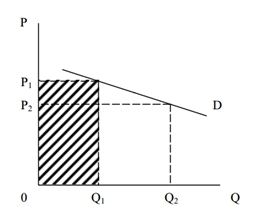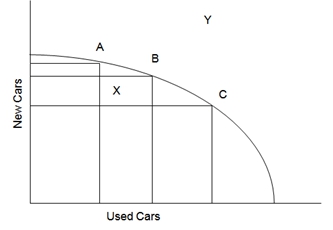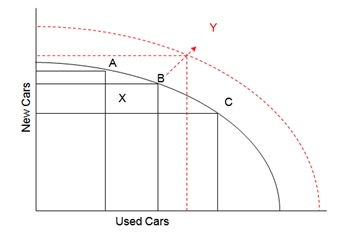The UAE is an economic miracle. Very few countries have achieved the feat that the UAE has managed to achieve in the last three decades. At the beginning of the twentieth century, the region was simply a vast desert. In fact, life in the region remained unchanged for many centuries until the discovery of oil in the fifties. What followed was a series of economic decisions that turned the region into an economic powerhouse in the twenty first century.
The country competes favorably with many western economies on indices such as the infant mortality rate, literacy levels, and healthcare standards. This paper explores the reasons behind the economic feats achieved by the UAE. In particular, the paper looks at the place of used car trade in the region and its economic significance. It also explores the role of technology in the UAE.
Attractiveness of the UAE to Foreign Direct Investors
The UAE is favourable to many investors for various reasons. First, the UAE has free trade zones that allow for full foreign ownership of businesses set up within these areas. Some countries insist that all companies formed by foreigners must have a percentage of local ownership. The issue of ownership is very thorny for many investors. This is because locals do not always have the interest to own part of a company established by foreigners.
At the same time, it may be difficult to get locals who have the resources required to own part of the new venture. The policy of having all businesses set up by foreigners to have local shareholding can limit the amount of foreign capital an economy can absorb. UAE did away with this limitation by establishing free trade areas.
The second factor that makes the UAE attractive to foreign investors is that the country allows foreign investors to repatriate profits. However, there are rules and guidelines that govern the process of repatriation of capital and profits. The effect of giving foreign investors the space to repatriate profit at will is that it makes the foreign investors feel free to pursue any opportunities that they meet in the future.
Investors would like to have the space to decide whether their businesses are worth running in a given territory. If the conditions become unfavorable, they prefer the flexibility to move to places with new opportunities. The profits laws in the UAE give them this option.
Thirdly, the UAE has a large expatriate population. The economic consequence of this is that a company that sets up its business in the UAE has access to professionals from almost every country on earth. This means that the UAE has the cultural mix to host successfully a global headquarter for any company. The cultural diversity in the country also makes it a place that can support innovation and cooperation among different cultural groups.
The fourth reason that makes the UAE very attractive to foreign investors is that the UAE has a very stable business environment, making operations in the country very predictable. This includes having excellent financial institutions that fund businesses and facilitate global transactions.
The country also has very good physical infrastructure that make it easy for businesses to carry out the logistical functions needed for successful operations. The country also has a very stable political climate. The UAE did not experience unrest because of the Arab spring when many Arab countries were undergoing political turmoil. Finally, the country has a well-established manufacturing sector, alongside a reputable service sector, which make doing business in the UAE convenient.
The reasons presented above represent some of the well-known factors that make the UAE an attractive destination for FDI. The UAE took great care to create a region that is attractive to international capital by solving some of the greatest challenges faced by foreign investors.
Factors Affecting the Demand and Supply of Used Cars
One of the main industries in the UAE is the import and export of new and used cars. The UAE has established itself as the world capital for used and refurbished cars. The country is also a transit point for new cars because of the connectivity of the country. The country has more than 100 airlines serving it, as well as more than 170 shipping lines.
This means that it is convenient and cost effective to route goods via the UAE. The used cars business is a very strong economic sector in the UAE. This is because of the increasing demand for cars among the growing global middle class. In order to understand what drives this sector, it is important to look at the used cars business in terms of the supply and demand of used cars.
The demand for used cars has grown steadily in the last two decades. This is because cars moved from the luxury items segment to the necessities segment in the closing decades of the twenty first century. The introduction of used cars made the Price Elasticity of Demand (PED) to become more elastic.
This means that used cars brought the prices of cars low enough to increase substantially the demand for cars. Figure 1 below illustrates the changes before and after the introduction is used cars in the global market. Q1 represents the demand of new cars, while Q2 represents the demand for used cars.

The supply of used cars is not elastic. This quantity of used cars that will be available for sale in a given year is already known from the primary sources. In this sense, the price of used cars responds more to demand rather than supply. The supply is predetermined.
The way of life is changing for many families across the globe. People no longer plan their lives around where they work because it is now easy to access the workplace by using a car. In addition to this, there is an increase in the number families where both parents have jobs.
This means that the choice of where the family resides is based on the distance to each parent’s workplace. In the developing world, many workers are taking permanent residence in and around cities because of affordable mortgages. At the same time, they are changing jobs very quickly. Therefore, people are less apt to move from their current homes to access their new jobs. They would rather buy a car to get to work. In addition, few people plan to spend the rest of their lives in the same company.
A growing middle class in the high population centers of the world is also fuelling demand for used cars. In countries such as Brazil, India, and China, more and more people are joining social classes that make cars a necessity. At the same time, these people do not always have the money to buy new cars. They therefore look for used cars to meet their needs.
The supply of used cars to the UAE comes mainly from Japanese used car auctions. The Japanese government discourages use of vehicles that are more than 5-6 years old. Old cars attract more taxes. This provides the incentive needed to buy new cars in Japan. The used cars to be disposed from Japan are sold through auctions and many of them find their way into the UAE.
Some are sold within the UAE, but a larger number are exported to other regions of the world. Provided the Japanese government retains its current policies, there will be a constant supply of used cars to support the used cars business in the UAE. This means that the used cars import and export business still has a lot of potential.
Productions Possibilities of the Most Demanded Products in the UAE
The UAE is better known as a business hub rather than as a production powerhouse. As such, it is difficult to look at the UAE as a production center. In the case of used cars, there are several reasons why it is not possible for their production to take place in the UAE. First, used cars are not a product, but a byproduct of the auto industry.
Japan makes new cars and after use in the country, it sells the cars to other nations. Usually these cars are refurbished to make them ready for export. Therefore, it is not possible for anyone to manufacture used cars. The used cars business depends on the disposed cars from other countries.
The only plausible way that the UAE can produce used cars is if it buys new cars for use in the country, and then sells them off after a number of years. The UAE does not have the same commitment to the disposal of cars as Japan. This means that the UAE lacks the capacity to replace all the cars it would have to sell to meet the demand for used cars, based on its current production of used cars. In other words, the UAE cannot produce used cars to meet the demand it currently supplies.
The UAE used car market will remain dependent on imports from Japan, and some European states. The Production Possibilities Frontier curve for the UAE shown in figure 2 below, demonstrates that production of new cars will require more resources than the current to import and export used cars, with the option of refurbishing some cars in the UAE.

The third reason why the UAE cannot produce used cars is that the UAE lacks the economic outlay needed to support an auto industry. Countries that have auto industries have several economic resources. These include capital, machinery for making automobiles, supply chains for acquiring raw materials, and human resource. A cursory look at the auto industries in other countries such as America, Japan, and Germany shows that these countries have developed an economic system that supports the auto industry.
In order to produce cars that will meet international standards, the UAE will need many years of careful investments. Apart from lack of the economic necessities that support the auto industry, the competition from well-established manufacturers would be unbearable. Companies such as Toyota and Nissan have invested heavily in their production facilities and attained economies that are very difficult to match. The UAE would need years to catch up. Even then, the cars produced would be new, and not used.
The final observation regarding the production of cars in the UAE is that it would commit resources the country can use more profitably in other areas. In this sense, the country is better off investing in trade and commerce rather than in an auto manufacturing industry.
Benefits of Used Cars Trade
The used car business creates employment for many of the people currently residing in the UAE. The UAE is home to a very large expatriate community. Census estimates puts the figure of foreign nationals living in the UAE at about eighty percent of all people in the UAE.
This means that the nationals of the UAE are about twenty percent of all the people living in the UAE. The large expatriate community is involved in many sectors of the UAE economy including the used cars business. It provides employment to many locals and foreigners.
The second benefit of the used cars business is that is provides foreign exchange for the country. The UAE imports used cars and then exports them to other destinations. The country makes money from used cars in two ways.
First, business people make a profit by participating in auctions in Japan, and then selling the units to other parts of the world. The second source of income from used cars is that the UAE serves as a transit hub for the cars bought by large-scale traders from other countries. If these traders choose to use the UAE as the transit hub, the country makes money from port and transport charges.
The third benefit of the used cars business is that it is contributing to the economic growth of the UAE. The sector grew in the recent years by a good margin. In the first two months of 2013, the industry grew by twenty-seven percent when analyzed on a year-to-year basis. This shows that the industry is contributing strongly to the economic recovery of the UAE.
The number of used vehicles that will be sold in 2013 is expected to grow by twenty seven percent. This will be the highest sales achieved in the last three years. This prediction comes from the analysis of global demand for used vehicles routed through the UAE.
The fifth benefit of the used cars business in the UAE is the offshoot businesses that have sprung up related to the used cars business in the UAE. First, there is a growing spare part sector within the automobile industry. Spares come from Japan via the UAE to other export destinations. Secondly, the country is enjoying a growth in tourism, as some people travel to the UAE to buy cars. When in the country, these buyers tour the region before going back home.
Thirdly, the UAE is establishing local industries that are becoming involved in the refurbishment of used cars. While a large portion of the used car markets gets its supplies from Japan, the UAE also generates some used cars for export. These cars require refurbishment before export from the UAE. This explains the emergence of a refurbishment industry in the UAE. The UAE also serves as a hub for the transport of used cars from Europe to other destinations.
How Technology Can Participate in the Economic Growth of the UAE
The UAE is however a net consumer of technology, rather than a creator and innovator. The use of technology in the economy of the UAE can benefit the country in two main ways. First, technology can act as an enabler in the improvement of operational efficiency in the country. One of the results of this is that the country will increase its production possibility frontier towards “Y” as shown in figure 3 below.

Secondly, technology can act as the basis for the development of a local industry to handle the technological demands of the trading partners of the UAE. The main competitive advantage of the UAE in international trade is its ability to handle a large volume of goods and services that are in transit very efficiently.
The country boasts of some of the most efficient ports in the whole world. Technology is already playing a major role in the management of the ports in the country. The country can handle large volumes of cargo for shipping or export largely because of the technological capabilities of its ports.
Secondly, technological growth is making the UAE a manufacturing hub. The country already produces some industrial products for export. In this sense, the country is benefiting from the application of technology to develop local industries. Most of the technology used in the country is imported from technology capitals such as Japan and the United States.
The third role that technology plays in the UAE is that it gives the country the infrastructure needed to operate the facilities that make it what it is today. For instance, it was impossible to build Burj without the use of technology. The building is the current titleholder for the world’s tallest building. In addition to its construction, the Burj is also dependent on technology to operate. As the only seven-star hotel in the world, the Burj uses very many technological devices to give its customers the luxurious experience that they seek in the hotel.
Technology can become an export item for the UAE, just as the UAE participates in export trade using imported goods and services. The country can benefit from trade in technologies and innovations that makes its ports the best in the world. Many countries would like to emulate the setup and operations of the UAE. These countries need the technologies that the UAE uses to run its export zones and its economy in general. The UAE can sell these technologies as a trade item.
Conclusion
The UAE can develop local firms that can create technological products for export. One of the easiest products that the UAE can create is software. Since the country is known as a logistics hub, it can specialize in the creation of logistics software to help exporters from other countries to manage their export businesses.
The country can also develop special economic zones modeled after Silicon Valley for the development of technological devices. The country is very good at creating special economic zones. The current development of Dubai Health City proves this fact (Deloitte 8). The use of a similar model for the development of technology firms can play a large role in making the country a technological hub.
Works Cited
Deloitte. 2011 Survey of the UAE Healthcare Sector Opportunities and Challenges for Private Providers. Survey Report. London: Deloitte, 2011.
The Oxford Business Group. The Report: Dubai 2008. Dubai: Oxford Business Group, 2008.
Thomas, Anne. Strategies for Branding Success. New York: eBooklt.com, 2011.